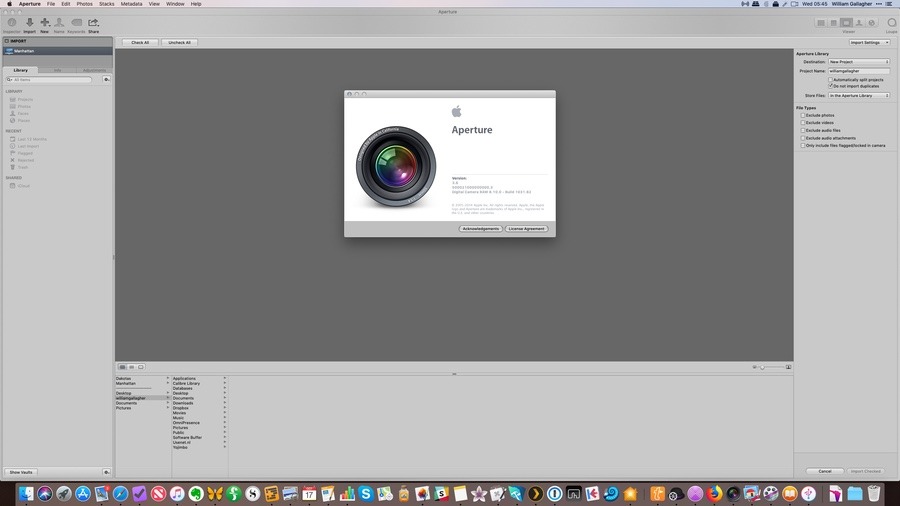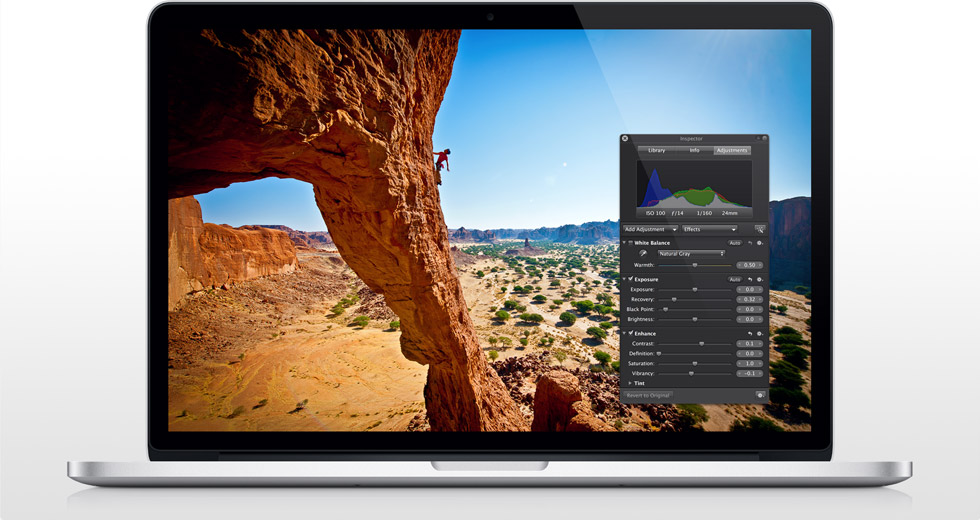
- Only Aperture 3.6 is fully compatible with MacOS X 10.10.3, so you need to update to version Aperture 3.6. After upgrading to MacOS X 10.10.3. But Aperture is no longer sold at the Mac App Store, and the Updates page will show 'Currently not available'.
- Aperture is a discontinued image organizer that was developed by Apple for the macOS operating system. It was first released in 2005 and was discontinued in 2015. The software handles a number of tasks common in post-production work such as importing and organizing image files, applying corrective adjustments, displaying slideshows, and printing photographs. Features of Aperture include non.
- Aperture works with most DNG files generated from cameras that support this format and with DNG files generated by the Adobe DNG Converter with the “Convert to Linear Image” option turned off. RAW Support Requirements. Aperture 1.5 or later with Mac OS X v10.4.11 Tiger or Mac OS X v10.5 Leopard or later.

In June 2014, Apple announced that development of Aperture has been discontinued. Since then, Apple has released six major macOS upgrades. For technical reasons, macOS Mojave is the last version of macOS to run Aperture. Starting with macOS Catalina, Aperture is no longer compatible with macOS.
Share your creations via Flickr, Facebook, or Apple's iCloud. Aperture 3.6 for Mac is free to download from our software library. This Mac download was scanned by our antivirus and was rated as safe. The unique identifier for this application's bundle is com.apple.Aperture. Aperture for Mac is categorized as Design & Photo Tools.
To continue working with your Aperture photo libraries, you must migrate them to another photo app. You can migrate them to the Photos app, which is included with macOS Yosemite or later, or migrate them to Adobe Lightroom Classic or another app. You should do this before upgrading to macOS Catalina.
Migrate your library to Photos
If you're using macOS Mojave or earlier
Aperture 3.5 Macro
Follow these steps if you're using macOS Mojave or earlier:
- Open Aperture.
- Choose Aperture > Preferences, click the Previews tab, then change the Photo Preview setting to Don't Limit. Close the preferences window.
- From the list of projects in the Library inspector, select all of your projects. For example, click the first project listed, then press and hold the Shift key while clicking the last project.
- Click the Browser layout button in the toolbar, so that all photos are shown as thumbnails.
- Choose Edit > Select All to select all of your photos.
- Press and hold the Option key, then choose Photos > Generate Previews.
- Aperture now generates full-size previews for every photo in your library. To follow its progress, choose Window > Show Activity from the menu bar. Quit Aperture when processing is complete.
- Open the Photos app, then choose your Aperture library when prompted, as pictured above. If you aren't prompted to choose a library, press and hold the Option key while opening Photos. If your Aperture library isn’t listed, click Other Library, then locate and choose your library.

When Photos shows the photos from your Aperture library, migration is complete.
If you're using macOS Catalina
Starting with macOS Catalina, Aperture is no longer compatible with macOS. If you upgraded to macOS Catalina before migrating your library to Photos, follow these steps:
- Install the latest macOS Catalina updates. Your Mac must be using macOS Catalina 10.15.1 or later.
- If you migrated your library to Photos after installing macOS Catalina 10.15 but before updating to macOS Catalina 10.15.1, complete these steps before continuing:
- Select your Aperture library in the Finder. By default, it's named Aperture Library and is in the Pictures folder of your home folder.
- Choose File > Get Info. An Info window for your Aperture library opens.
- In the Name & Extension section of the Info window, replace .migratedphotolibrary at the end of the file name with .aplibrary. Then close the window.
- Open the Photos app, then choose your Aperture library when prompted, as pictured above. If you aren't prompted to choose a library, press and hold the Option key while opening Photos. If your Aperture library isn’t listed, click Other Library, then locate and choose your library.
When Photos shows the photos from your Aperture library, migration is complete.
Migrate your library to Adobe Lightroom Classic
Adobe Lightroom Classic version 5.7 and later includes a built-in tool for migrating Aperture libraries to Lightroom catalogs.

If you’ve upgraded to macOS Catalina, learn about compatibility with Lightroom Classic.
When an Aperture library is migrated to Lightroom, your library's organization, metadata, and image adjustments are preserved, with some exceptions:
- RAW files are migrated, but Aperture's non-destructive adjustment layer does not. Lightroom’s migrator tool includes an option to export and migrate Aperture’s full-size JPEG previews for edited images. If you want to preserve your Aperture edits in another format, export the edited images from Aperture first, then reimport them into Lightroom after migrating your library.
- Projects, folders, and albums are migrated to Lightroom collections and collection sets.
- Faces, color labels, and stacks are migrated as keywords.
- Rejected images are migrated to a collection.
- Slideshows are migrated as collections.
- Smart Albums and custom metadata fields aren't migrated.
- Album organization is alphabetical, so manual sidebar organization might not be preserved.
- Custom metadata fields aren't migrated.

Export your Aperture library
You can also export the contents of your Aperture library to back it up or to import into another app.
Its a chicken and egg scenario with Yosemite and Aperture. You just hit the “update” button and finally gave in to installing Mac OS X 10.10, Yosemite on your Mac.
Aperture 3.5
Its only upon completion you realise that the last version of Aperture was 3.4.5 and now it does not work with Yosemite….
Here’s how to make it Yosemite friendly.
What needs to be done is to update Aperture from 3.4.5 to 3.6. Yes, you read right. 3.6.
No, you didn’t miss any updates. It just jumped a few versions ahead to 3.6.
The most common complaint is that Aperture cannot be updated once you’ve installed Yosemite. All you see is the Aperture application icon with a no entry sign painted across it and even if you launch App Store you cannot find Aperture 3.6 update anywhere.
Aperture 3.5 Macular Degeneration
Here’s how to force update Aperture from 3.4.5 that is incompatible with Yosemite to 3.6:
- Drag the Aperture application into the trash but don’t empty the trash (just in case)
- Launch App Store and click on the Purchases tab, find the Aperture application in the list (assuming Aperture is a paid app) and click “Install”
- Upon completion, you should now be the proud owner of Aperture 3.6!! Which is… compatible with Yosemite!!
- Hold down the Option key and click Aperture to launch it and when prompted select your Aperture library to re-link your existing library to Aperture 3.6
- When prompted to update the older 3.4.5. Aperture library to 3.6 agree and wait for the update process to complete
Aperture 3.5 Macbook Pro
Give your new Aperture 3.6 a trial run and once you’re satisfied, you can safely delete Aperture 3.4.5 from your trash bin.